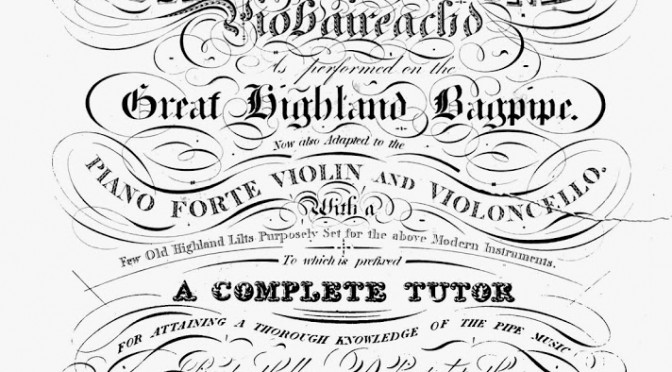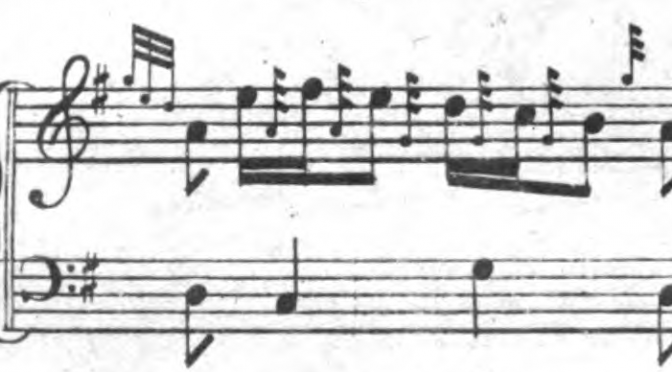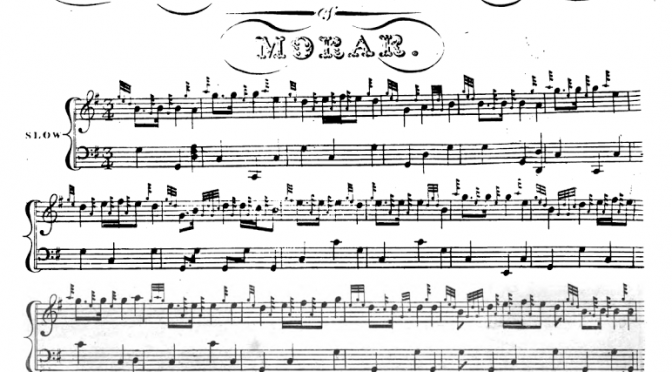On Saturday in the Wighton Centre, we were talking about Rory Dall Morrison, the blind harper of Dunvegan in the 1690s. So today I went back to my PDF Rory Dall tune list, and added in all the tunes for his songs. I was also bolder in moving more of the tunes and one of the song airs into the ‘misattribution’ section.
Category: research
An Caoine Rioghaill – The Royal Lament
I was at Balgay parish church in Dundee today, presenting the replica Queen Mary harp and playing some old Scottish harp music. One elderly gentleman who was a member of the church guild and a piper was unable to attend but had sent in a question, saying he knew of a pipe tune which was a lament for the King, and which he believed was traditionally said to have been composed by an old harper out West.
Lecture at the University of St Andrews
On Thursday morning I have to give a lecture on the harp traditions in Scotland, as part of the MU2002 Scottish Music undergraduate course.
It is pretty difficult to summarise all aspects of the harp in Scottish music in just 50 minutes!
Playing ceòl mór from Donald MacDonald’s 1820 printed book
I am intrigued by Donald MacDonald’s arrangements of ceòl mór or pibroch, because on his title page he indicates that he is not setting out the tunes in “pipers tablature”, that cryptic system that looks confusingly similar to staff notation; instead, he describes his work:
A / collection / of the / Ancient Martial / Music of Caledonia / called / Piobaireachd / as performed on the / Great Highland Bagpipe / Now also adapted to the / Piano Forte, violin and violoncello…
By setting the music on two staves, treble and bass, he intends that the purchasers of his book, price one guinea (£1 1s, or a few hundred pounds in today’s money) to play this music not on the pipes (what wealthy, musically literate book-buyer in 1820 owned or played pipes?) but on the piano; if they had musical guests at their Edinburgh townhouse they may well also try it as violin and cello duets.
Donald writes a single bass line very simply in the bass clef, which looks to me quite old-fashioned for 1820; I think by that date many music arrangers were writing chordal and thicker textures in the bass. On the other hand the modal, drone-based nature of the music may have discouraged anything more complex.
He writes the melody in a more nuanced way, setting the tune in large notes with their stems all pointing down, and using little notes with the stems up to indicate the characteristic bagpipe grace-notes. I imagine he expected piano and fiddle players to ignore these in performance, but to appreciate them as exotic talking-points read in connection with the “instructions” at the beginning of the book.
How did he decide which notes to make big, and which small? This is the vexed question of all early pibroch scholarship, since there seems to have been a strong movement through the 19th and 20th century to shift the musical emphasis in a big way, with melody notes becoming swallowed up into bundles of gracenotes, and rogue grace notes being held so long that they speak as stressed melody notes.
My opinion is that he wrote the big notes so that when played normally on the fiddle or piano, the melody sounded as he imagined in his head that it should, based on his knowledge of the expected traditional expression of this tune on the pipes (and perhaps also on the fiddle, seeing as the fiddle pibroch tradition may have still been reasonably strong at this time)
More on Ronald MacDonald of Morar’s Lament
Today I tried playing the Lament for Ranald MacDonald of Morar on the harp, and I discovered two very interesting things about this tune.
First, it really does not sit well on the harp.
Secondly, it is a minor-mode tune. The notation gives it in a, as is usual for Highland bagpipe music, as the pipes usually play an a major scale: a b c# d e f# g a, plus low G, with drones sounding all the while on A.
This tune is mostly pentatonic, moving over g a b – d e – g a, with passing notes on f# and on c natural. The c natural is not at all what one would expect to hear in a pipe tune, yet not only does c# sound very wrong but the notation clearly gives only one sharp in the key signature.
Listening to the only pipe recording I have to hand (and ignoring the substantial changes to pulse and accent) I note that the issue doesn’t arise on the pipes, because the sequence that Donald MacDonald writes very clearly as d (G) c (G) b, i.e. a descending series of 3 notes d c b, separated by low G gracenotes, becomes in modern performance d G(c#)G b, i.e. a sequence of two notes d b separated by a burble on low G. So the tune remains pentatonic on the pipes.
I checked in Joseph MacDonald‘s book, where he has a section on the “keys” in which ceòl mór is set on the pipes, he doesn not really deal with this type of scale; he only talks about laments omitting c# and concentrating on the low end of the scale. Other than that he is mainly interested in music set in modal equivalents of g major, a major and d major.
Cumha Raonuill Mhic Ailein Òig
Today I have been working on Cumha Raonuill Mhic Ailein Òig, the Lament for Ronald MacDonald of Morar. It is working very nicely as a fiddle tune. I am following Donald MacDonald’s 1820 printed arrangement:
It continues for three more pages with the variations; so far I have been concentrating on the first variation and its doubling. Donald MacDonald’s setting is strangely assymetrical with startling developments of the melody in the second half of the tune; Angus MacKay’s manuscript seems to be the same though I don’t know if MacKay was just copying MacDonald or whether he had the tune independently from oral tradition. All the later sources hack about with it and remove bars to make it four-square and much less dramatic.
I’m tuning the fiddle a-e’-a’-e” (though as usual I keep it one note lower than modern pitch), as this allows the tune to be played mainly on the two highest strings, with the two lowest acting as intermittent drones. I’m finding this tune sits very well on the fiddle, with pleasant string-crossings and open intervals.
I’m not planning to play this on the harp, out of respect for Ranald – if he was, as tradition says, one of the last of the old harpers, whoever composed this fine lament after he died would not have been a harper, though they may well have played fiddle as well as pipes.
Hopefully I will put up a Youtube of it at some point though I already have a backlog of things to record!
Prof. Fergus Kelly, Early Irish Music: An overview of the linguistic and documentary evidence
 Professor Fergus Kelly presented the 2013 Statutory Public Lecture of the School of Celtic Studies on Friday 15th November at 8pm, Thomas Davis Theatre, Arts Building, Trinity College Dublin.
Professor Fergus Kelly presented the 2013 Statutory Public Lecture of the School of Celtic Studies on Friday 15th November at 8pm, Thomas Davis Theatre, Arts Building, Trinity College Dublin.
You can now get a video of the entire one-hour lecture plus a PDF of the handout with lots of further reading references, from the DIAS website
Playing position of medieval Gaelic harp
When I was in the National Museum of Scotland earlier this month, I was looking at the Queen Mary harp, and I noticed the wear on the lower back left corner of the soundbox. The corner of the box is quite worn away, and there is a wooden patch nailed on to the back of the box at this point, an old repair.
The wear on this corner was mentioned and drawn by R.B. Armstrong in his book The Irish and the Highland harps (David Douglas, 1904), though he talks mostly about sliding the harp along the floor when it was put down, Keith Sanger and Alison Kinnaird in their book Tree of Strings (Kinmor 1999), p.57 repeat Armstrong’s observations. Karen Loomis in her MMus dissertation (University of Edinburgh, 2010), p.49, includes a photo and a mention of this wear, but she is mostly concerned with the cracks from the repair patch nails.
I realised that the shape of this worn area is not just caused by general sliding of the harp, but instead it forms a flat surface which seems to me to be where the harp was stood on this corner when it was being played. You can see in my photo how the flat worn patch lines up with the projecting block of the bottom of the soundbox:
A long time ago I realised that if you sit on the floor to play a replica of the Queen Mary harp, then the harp naturally tips to rest on its projecting block and also this corner of the soundbox.
The angle of the flat panel therefore gives us a quite precise evidence for the angle that the harp was held at.
I propped my replica up on a hard surface, and adjusted the angle until my photo of my replica matched my photo of the original in the Museum:
And then, without moving the harp at all, I photographed the orientation of the harp, from floor level, at right angles to the plane of the strings, and also in line with it:
I think this gives a fair estimation of how the Queen Mary harp was positioned when it was being played.
Obviously there is some margin for error; the bottom of the projecting block would wear away and the corner of the box would wear away, so the angle in the front view would change over time. Also the flat worn surface is not entirely flat, but curves up towards the replacement piece. My positioning of the harp matches the most upright position. I would estimate that there could be 5 degrees either way since I was just doing this all by eye. The curving probably represents the harp being slid down to rest on its back as Armstrong suggests.
You’ll see that the strings are pretty much upright in the side-view photo.
The harp rests back quite a way behind its balance point. My replica won’t balance on that line between the box corner and the projecting block – if you tip it far forward enough to balance, it falls over sideways.
I looked again at Paul Mullarkey’s photos of the Trinity College harp. The soundbox is much more eaten away than the Queen Mary’s, especially at the bottom. However, the back bottom right corner of both the soundbox and the back panel are preserved, whereas the back bottom left corner is completely gone and is replaced now with extensive resin filler.
Early Irish Music: An overview of the linguistic and documentary evidence
Professor Fergus Kelly will present the 2013 Statutory Public Lecture of the School of Celtic Studies on Friday 15th November at 8pm, Thomas Davis Theatre, Arts Building, Trinity College Dublin.
What do the early Irish texts tell us about the history of music in this country? The main emphasis in this lecture will be on the period between the coming of Christianity in the 5th century and the Anglo-Norman invasion in the late 12th century. Topics to be discussed include the identification of the stringed instruments crot and timpán, the use of wind-instruments in military contexts, the development of bag-pipes, the functions of percussion instruments, and the various styles of singing mentioned in the texts. There will also be an account of the evidence for dancing in early Christian Ireland.
The lecture will conclude with a summary of the role of music in early Irish society, and a discussion of the Church’s attitude towards different types of music, as well as an account of the frequent association between music and the supernatural in early Irish literature.
Admission is free and open to the public; there is no need to register.
Part of Tionól 2013. Thanks to Maura Uí Croínín for passing this on.
Just intonation
I have been interested in just intonation as a way of tuning the harp since 2009 I think. Recently I was chatting about this and I was asked, is there a simple instructions or directions about how to tune the harp just?
It is not possible to have every interval on an instrument like a harp perfectly in tune. As soon as you make some intervals perfect, others become sour or dull. There are various solutions to this, and I wrote in 2009 describing some of the possible tunings for early Gaelic harp. Equal temperament is the modern scientific solution, making every interval a little bit equally out of tune. Historical systems that are usually used include Pythagorean tuning, which makes all the 5ths and 4ths pure but leaving the 3rds very rough, or Meantone which makes all of the major 3rds pure, leaving the minor 3rds and the 4ths and the 5ths sour. Just tunings on the other hand make different intervals of the same “class” different sizes, so some 4ths, 5ths, minor 3rds and major 3rds are pure, whilst others are out.
Just tunings are the most obvious solution for a diatonic instrument, because you can maximise the amount of consonance without having to take account of all the sharps and flats and key changes that you find in a chromatic instrument.
I have made up three instruction / demonstration sheets which show three possible just tunings that you can try on the harp. The first is pretty much the way I have been doing things, deliberately since 2009 and “accidentally” for somewhat longer I think. This one is pretty easy to tune on the harp, as the 5ths are all pure except the 3rd one in the sequence from a up to e, and if you listen to the sympathetic hum of the harp it is not hard to sound this 5th and tune it narrow so the e sounds pure against the sympathetic g drone of na comhluighe.
The third one is based on Highland bagpipe scales presented by Seamus MacNeill and also by Barnaby Brown. It is tuned exactly the same as the one above except that when you start the cycle of 4ths you push the c wide to make it sound wild and scary, just like on the pipes.
The middle one is a kind of half-way house I have made up. I think it’s harder to tune because your narrow 5th is the second in the sequence, d up to a. The a is not speaking so clearly against the sympathetic drone of the harp, so even though this tuning has more consonances than the other two I don’t think I will end up using it. But it’s in there as an option to think about. You’ll notice that it is a transposed version of the first: scale 2 with f natural is the same as scale 1 with f#.
The circles showing the consonant intervals are also useful if you want to think about the properties of different modes. You might think that the pentatonic scales c-d-e-g-a and g-a-b-d-e and f-g-a-c-d would all sound the same, but a glance at the chart will show that this is not the case at all!













